|
1.
CENTRAL/ WEST AFRICA
Prices remain stable at month end
Log markets remained stable through the end of July, despite the ongoing lower demand from
China. Prices for Asian destinations were constant after some minor falls earlier in the month that
were restricted to less popular peeler logs. There was little doubt the implementation of
the log export quota systems in Congo Brazzaville and Gabon helped steady the market. Some small price
adjustments for Europe were only in species that were of little interest to continental European
buyers. In addition, the log market for India continued firm and stable with
regular demand unchanged.
Sipo and sapele logs were still in demand for all markets and prices were firm at the recently
increased prices. Sipo and sapele sawn lumber evened out after noticeable price
increases in June. All other sawnwood species were firm and held the price increases achieved through June and
early July. Although producers report markets as dull, there was some confidence about the market
prospects for the third quarter.
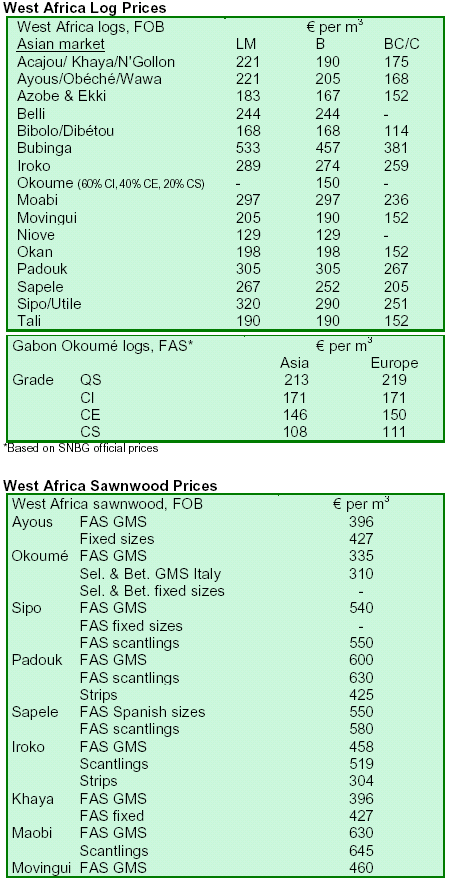
2. GHANA
New Minister of Lands, Forestry and Mines in Ghana
Eight top ministers vying for the 2008 presidential slot of the NPP political party have recently
resigned from their government posts. As a result, President J A Kufuor has announced a cabinet
reshuffle in his government, which has affected the Ministry of Lands, Forestry and Mines.
Pending approval by the Parliamentary Select Appointments Committee, Miss Esther Obeng Dapaah will
replace Professor Dominic Fobih, the former minister of the Ministry of Lands, Forestry and Mines.
Before Prof. Fobih departs the Ministry, he will have launched a website for the
Ministry¡¯s Land
Administration Project (LAP), which will be available at www.ghanalap.gov.gh. The website will
contain comprehensive information on Ghana¡¯s land administration system, and include information
from the Survey Department, Town and Country Planning, Land Valuation Board, Stool Lands, Land
Title Registry and the Ministry of Lands, Forestry and Mines. Prof. Fobih said
the underlying principle of the website would be to provide access to information as well as serve as an
interactive platform for the policies and activities being implemented by the Ministry.
Legal framework to save forests from over-exploitation
A two-day capacity-building workshop on forestry legal frameworks was held in Dambai in the
Krachi East District of Ghana. It informed forest fringe communities of forest laws and their
responsibilities to enforce them. The workshop was organized by the Forestry Resource Use
and Protection Management (FORUM) Project and funded by the German organizations GTZ and
KfW. Deputy Volta Regional Manager of the Forestry Services Division (FSD), Mr. Obed
Kass-Yerenchi, said Ghanaians would suffer the consequences of forest degradation if measures
were not instituted to check over-exploitation of forest resources. He called on stakeholders, especially Chiefs and
fringe communities of protected areas to enforce legal frameworks or ¡¡ãcollectively, we sign our death warrants,
because when the forest dies, mankind also dies¡¡À.He said Ghana¡¯s forestry and wildlife
legislation required all stakeholders to assist in the protection of the nation¡¯s
forests and renewable natural resources.
AGI calls for more government support to industries
During the launch of the Association of Ghana Industries¡¯ (AGI) 50th anniversary celebration, Mr.
Oteng-Gyasi, AGI President, urged the government to do more than just create an enabling
environment for the private sector. He said the government should sometimes lead the private
sector into trade negotiations since some deals were better initiated by the government. He noted that
Ghanaian industries could not break into the international market without direct government support.
Even with the help of the African Growth and Opportunity Act (AGOA), the government would still
need to be keenly involved in promoting the private sector to raise its status.

3.
MALAYSIA
Weak financial markets impact Malaysian timber products
Prices of Malaysian timber products were impacted by weaknesses linked to the instability in the
world¡¯s financial markets and further softening of the U.S. real estate market. As a result, prices of
sawn timber, plywood and panel products failed to rally in the wake of the severe
flooding in the UK. Malaysian timber markets were particularly affected in comparison to Nordic and other
EU markets. Longer delivery times from Malaysia were a primary disadvantage in supplying timber for the
reconstruction efforts.
FRIM focuses research on biodiversity conservation
The Forest Research Institute of Malaysia (FRIM) will implement a five-year research programme in
Temenggor Forest Reserve in the state of Perak to address current and impending issues of
biological diversity conservation in forestry. As reported in FRIM in Focus (and TTM 12:12),
the quarterly in-house newsletter of FRIM, the project was funded by the United Nations Development
Programme¡¯s (UNDP) Global Environment Facility (GEF), ITTO and the Malaysian government. The
project will be overseen by the Ministry of Natural Resources and Environment
and implemented by FRIM. It will offer sound solutions to some of the main issues in biodiversity conservation
through the UNDP-GEF-ITTO Conservation of Biodiversity Project entitled ¡¡ãConservation of Biological
Diversity through Improved Forest Planning Tools¡¡À. The project, which was funded in April, will focus on
Temenggor Forest Reserve, a natural reserve that contains part of the largest remaining blocks
of natural forest in Peninsular Malaysia.
Central Bank keeps OPR at 3.5%
The Monetary Policy Committee of the Malaysian Central Bank left its Overnight Policy Rate
(OPR) rate unchanged at 3.5%, reported RTT News. The decision was in line with
expectations, as inflation had eased substantially to 1.4% in June and averaged 2.0% annually in the first half of the
year. The Central Bank said that the overall growth of the economy remained favorable in the first
half of the year. The Bank said the slower growth in the external sector was being balanced by
domestic demand. Greater economic momentum is expected in the second half of the
year as robust domestic consumption along with higher investment would likely complement an upturn in
external demand, particularly from Malaysia¡¯s trading partners.

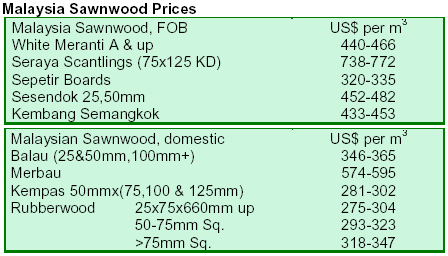
4.
INDONESIA
Indonesia spurs initiatives on reforestation
The Indonesian government continues to spearhead its reforestation initiatives, moving to plant two
million hectares of forest areas a year as the country moves towards industrial forest estates. As
reported by ANTARA News, Forestry Minister MS Kaban requested all relevant parties to give more
support to the Indonesian initiatives on forest rehabilitation and conservation. This continued
recent government work on reforestation in rural areas, such as initiatives focused on planting young
yangon trees (TTM 12:11) and offering low interest loans to villagers to plant trees (TTM 12:13).
In addition, Indonesia will introduce a regulation that curtails tree felling from 30 to 9.1 million m3
each year. Forestry Minister Kaban noted that forest rehabilitation and conservation in addition to
fighting illegal logging are priority programmes of the forestry ministry, especially
since illegal logging is still rampant in Indonesia.
Perhutani foresees higher revenue in 2007
The State Forestry Company Perhutani has projected its revenue will reach Rp2.415 trillion in 2007,
a rise of Rp500 billion compared to 2006. The target would include a sum of Rp700 billion that would be set aside for the state
coffer. Perhutani president director Transtoto Handadari noted that 75% of the projected revenue would come from
timber production and the remaining 25% from non-timber production sectors.
Indonesia gains funding from Australian forest initiative
The Australian Embassy in Jakarta recently issued a press release indicating the Australian
government would commit Rp77 billion (A$10 million) to reduce greenhouse gases from
deforestation and promote sustainable forest management in Indonesia. Australian Foreign Minister
Alexander Downer and Minister for the Environment and Water Resources Malcolm Turnbull
announced the initiative at a high level meeting on forests and climate change. The press release
said the funding was being provided from the Australian government¡¯s Rp1.54 trillion
(A$200 million) Global Initiative on Forests and Climate.
Prices remain steady as rupiah slips
Prices of Indonesian timber products remained steady as the Indonesian rupiah slipped against the U.S. dollar.
Although extensive flooding devastated parts of Central Sulawesi and a severe
earthquake rocked Maluku, these events were not expected to affect prices of timber
products in the near future.
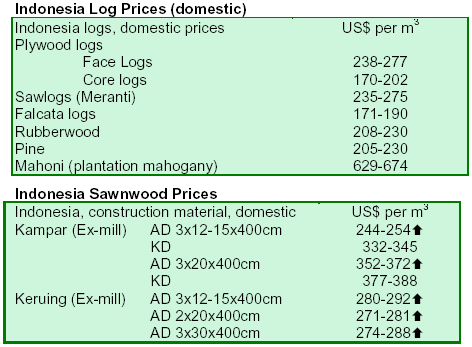
5.
MYANMAR
Forest carbon offsets could earn Myanmar US$1 billion
The Myanmar Times and Business Reviews have reported that Myanmar could earn US$1 billion in
carbon trading by protecting its forests. Based on an initiative under the UN Framework Convention on Climate Change,
industrialized nations would pay nations to protect their tropical forests in order to offset greenhouse gas emissions
under the Kyoto Protocol. Industrialized nations would deposit money into a conservation fund for Myanmar,
which it could draw upon. Myanmar estimates that the fund could reach a value of US$1.6 billion if its entire
forest area were conserved.
At present, Myanmar emits 32 to 93 megatons of carbon dioxide, although Myanmar could earn $8 to $32 if it
prevents one ton of carbon from escaping into the atmosphere. If implemented
successfully, the initiative could raise Myanmar¡¯s per capita income by 25%. The
report quoted U Ohn, General Secretary of the Forest Resource Environment Development and Conservation
Association (FREDA), who noted that if the plan were accepted, it would be good for business,
wildlife and the climate. However, he mentioned that the initiative would affect the forest products
industry and require consultations between wood-based industries and the government before being
implemented.
Teak prices show continued resilience and strength
Teak prices were rising, as only 2520 hoppus tons were available to buyers. While the Myanmar
Timber Enterprise (MTE) might have harvested its targeted quantity for the year, the supply of logs
for tender sales fell very short of demand. The local wood industry also reported a shortage of raw
material. Many buyers had accepted the six months¡¯ average pricing, although there
was no ruling yet on the price of industrial raw logs.
As seen in the chart below, the average price for Grade-8 was higher than that of Grade-7, mostly
because all Grade-8 logs came from an area preferred by almost all buyers. Only 11 of the 70 tons
of Grade-7 logs came from this area. The remaining 59 tons were from second or third
choice areas. Yet, teak continued to show strength by selling at high prices in the tender sales.
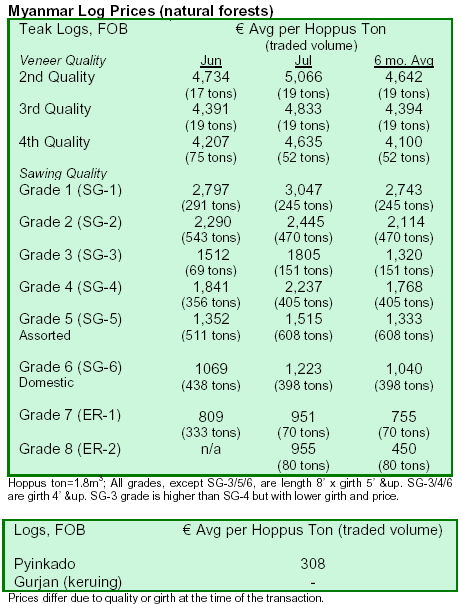
6. BRAZIL
ITTO conference showcases
Acre¡¯s strength in
community forestry
From 15-20 July 2007, the first International Conference on Community Forest Management was
held in Rio Branco, State of Acre, to discuss community forest management worldwide. Over 250
participants from 41 countries attended the conference, which was sponsored by
ITTO, Rights and Resources Initiative and the Brazilian Government.
According to the Brazilian Environmental Ministry (MMA) and the state authorities, Acre doubled
the size of its conservation forests from 5 to 10 million hectares in five years, with 60% of public
forests under community management. MMA expects that over 30 million hectares
of conservation forests would be created in the next ten years. Community forest management already represents
16% of the gross industrial production of the state.
According to ITTO, world wood markets and wood products from communities in tropical countries
amount to about US$150 billion per year. During the meeting, it was noted that the sector suffered
from excessive bureaucracy and lack of government support. However, Brazilian
organizations suggested that problems faced by communities could be reduced by the creation of lines of
credit for forest dependent communities, improved land regulation and increased infrastructure
investments.
COPOM cuts interest rates as IPCA climb continues
The National Consumer Price Index (IPCA) of June 2007 revealed another high of 0.28% and an
accumulated IPCA for the year of 2.08%, higher than the same period in 2006. The average
exchange rate in June 2007 decreased 2.5% from May. The Monetary Policy Committee
(COPOM) also announced a cut in the prime interest rate to 11.5% per year and the real interest rate to 7.7%,
removing Brazil¡¯s reputation as having the world¡¯s highest interest rate.
Sawmills air grievances over Sisflora
As reported by AIMEX, sawmills in the state of Mato Grosso have faced difficulties issuing Forest
Guidelines on the transportation of logs and wood products. This is due in part to the Wood
Products System of Registration, Commerce and Transport (or Sisflora), which allegedly
causes constant disruptions, complicating access of sawmills to the system. The Northern Mato Grosso
Association of Sawmills (SINDUSMAD) and other representatives met with the State Secretary of
the Environment to find solutions to this problem. According to the Association, a potential solution
would include the implementation of a new service provider. The current lack of Forest Guidelines is
an obstacle to transportation of the wood products to ports, resulting in lost shipments.
Brazil posts hefty increase in furniture imports
Between January and April 2007, furniture imports increased by 45%, compared to the same period
in 2006. In the first half of 2007, notes the Gazeta Mercantil, imports were 45% higher than the
same period in 2006. If the current momentum continues, Brazil¡¯s furniture
imports may reach US$280 million by year end. The appreciation of the Brazilian real and the increase of raw
material prices are the two major factors leading to decreased competitiveness of Brazilian wood products in
the market. While entrepreneurs and local businesses have been compensated by sales in the
domestic market, profitability has decreased over the last three years.
The U.S. is the top buyers of Brazilian furniture products, although the value of exports to the U.S.
have drastically decreased to US$126.7 million in the first half of 2007. Brazil will continue exploring
markets where price is not the driving force, and where creativity, design, and quality
combine with price advantages.
Para exports soar on strength of value-added products
As noted in Folha da Mata online, the Amazonian state of Para has increasingly added value to its
wood products. Compared to the first half of 2006, the value of exports increased 36.7% in 2007.
The expansion can also be attributed to the international price increases and quality
improvement of wood products. Regarding the volume, which has increased 13.5% in the first half of 2007, the
current production is based on utilization of stocks harvested in 2006 and market expansion of
manufactured products.
Para¡¯s main exports are flooring, decking, moulding, sawnwood and plywood, which in the first half
of the year, represented 94% of the total wood product exports of the state. In particular,
woodworking and carpentry products have gained markets as exports increased in value by 107%
and in volume by 41%. The sector¡¯s main concern to its performance is that 2007 timber harvesting
is threatened by the delayed approval of sustainable forest management plans by government
agencies and the falling U.S. dollar. Without stocks of timber for industrial
purposes, the state faces the risk of losing competitiveness, and wood product exports may show negative
performance in the second half of the year.
Furniture bucks retreating trend in wood products
Exports of wood products (except pulp and paper) decreased 6.9% in June 2007 compared to the
same period in 2006. Exports of tropical sawnwood fell 13.6% in total value and 18.8% in volume.
Tropical plywood exports also decreased in volume by 3.1%, but increased 3.6% in
value from US$20.1 million in June 2006 to US$20.9 million in June 2007. Brazilian exports of wood furniture
also grew 7.7% in June 2007 compared to June 2006.
Prices of wood products in the domestic market did not change significantly. The average prices of
wood products increased approximately 3.7% compared to prices in June, as seen in the table
below. Prices were mostly affected by the falling U.S. dollar.
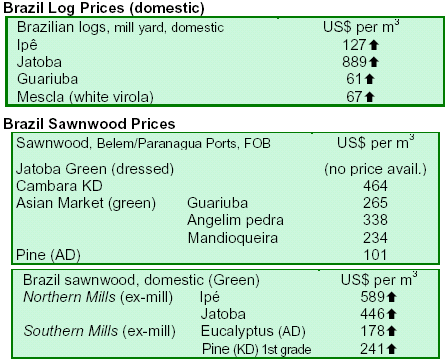
7. PERU
Government considers
INRENA¡¯s long term plan on reforestation
Following the completion of INRENA¡¯s proposal to reforest 2 million hectares of forest in the next 20 years
(TTM 12:10), Peru¡¯s Minister of Agriculture, Mr. Ismael Benavides, presented the proposal to
the Economy Commission of the Congress. Minister Benavides explained that the proposal would
involve reforestation of the poorest zones in the Peruvian highland and jungle
regions over the next 20 years using private capital and modifying the Law of Promotion of Private Investment in
Forest Plantations and Agroforestry. Noting that in the last 40 years, 8.5 million hectares of forested had
been destroyed, he said the initiative would bring more resources to the country and improve the
quality of life in the poor forest zones by generating employment and exports.
The Minister of Agriculture also pointed out that the Law in force gave land concessions for
reforestation for 60 years and investors showed no interest and asked for more
guarantees, thereby delaying a series of opportunities for Peru. Minister Benavides illustrated this using a
comparative chart showing how Peru was behind neighboring countries in generating employment in forest
plantations for commercial use. Peru employed two thousand people in such activities, whereas
Chile employed 250 thousand and Brazil 800 thousand.
Additionally, Minister Benavides said promoting reforestation with the help of the private sector
would lessen the current gap between lumber exports and imports, representing earnings of
US$200 million and US$400 million, respectively.
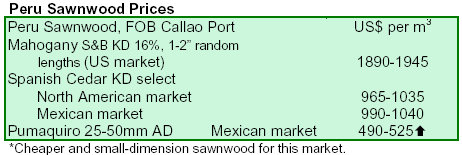
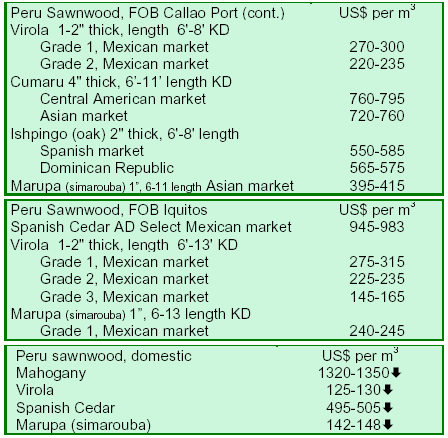
8. MEXICO
Agreements signed to promote
CONAFOR¡¯s ProTree programme
The National Forest Agency (CONAFOR) has signed an agreement with the Institute for Agricultural Trusts
(FIRA), through the Bank of Mexico and Financiero Rural, in order for PROTREE
beneficiaries to use subsidies for plantations. The agreement will guarantee
that resources contributed by the parties in the agreement are used to increase loan credits in the forest sector.
CONAFOR and Financiero Rural have guaranteed up to 1 million pesos in credit. They have also
initiated a financial instrument called FinArbol, which is a loan scheme for
producers supported by CONAFOR¡¯s PROTREE programme. The Minister of Environment and Natural
Resources has affirmed the importance of the agreements to boost financial assistance to businesses that will
create sustainable forestry activities. The Minister explained that the agreements would fortify the
forest sector, which was essential to Mexico¡¯s economic and social growth.
Germplasm to boost reforestation efforts in Veracruz
The Veracruz Bank of Forest Germplasm has discovered a method to produce a threefold increase in the amount of
pine seedlings in one year. The research results are expected to advance reforestation plans in Veracruz.
9.
BOLIVIA

10.
GUYANA
Guyana sustains strong growth in forest products exports
Guyana¡¯s exports of forest products during the first half of 2007 were approximately US$29 million. This represented
a US$3 million increase, or 10% growth over the same period for 2006. Logs, lumber and plywood continued to
be the major products exported and accounted for over 75% of exports. However, log exports had decreased by
about 10%, or 10,000 m3 during the same period for 2006. This is attributed to producers¡¯ focus on more processing
activities in anticipation of the government¡¯s new Log Export Policy, which is due to be implemented shortly.
New law gives GFC stronger footing to achieve SFM
The Guyana Forestry Commission¡¯s (GFC) bill was passed in the National Assembly on 26 July
2007, with the House making two amendments to Article 16. Agriculture Minister Robert
Persaud, who piloted the bill, said the new bill modernizes the GFC Act of 1979 to better help the
GFC execute its mandate of promoting sustainable forestry management for social, environmental and economic benefits to all forest stakeholders.
Persaud informed the House that the GFC would be given an enhanced ability to monitor, develop
and regulate forestry activities in keeping with new environmental best practices established for
forestry management. The new legislation provides for compliance with international
policies which have been driven by the EU and the World Wildlife Fund (WWF), specifically the voluntary
partnerships agreements associated with the Forest Law Enforcement Government and
Trade(FLEGT) initiative and the Global Forestry Trade Network (GFTN). Persaud
also noted the valuable role being played by Amerindian communities with respect to forestry development and the
forestry sector as a whole.
The new law is seen as important because it allows for the realistic evaluation of forests and
forestry products, which are regarded as great assets of the state. In accordance with
this, the GFC bill empowers the agency to assess the true value of the resource.
Among the features in the legislation are an entire new section on rules for financial operations to
improve financial accountability and management, a section on human resources policy for the
GFC, and stiff penalties for violating the confidentiality of business related
information. The new bill, when it comes into effect, would also allow for greater use of entities such as the
Forestry Training Center and the Forest Products Marketing Council (FMPC). Members of the House noted
that the new legislation spells out clear guidelines for the employment of persons by the GFC, which were
absent in the 1979 Act, and gives greater independence to the GFC. It also clearly defines lines of
authority and chains of command, distinguishing the roles of the Commission and
the Commissioner of Forests. Others argued that it seeks to remove the political influence of the
GFC.
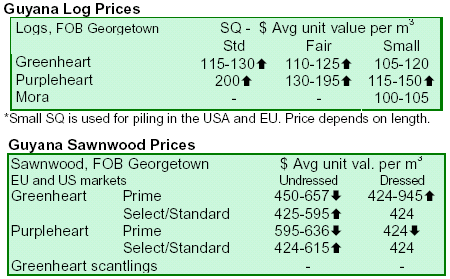
|